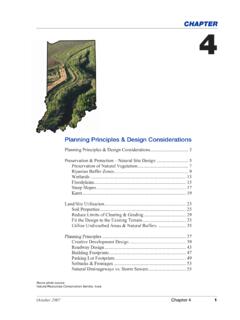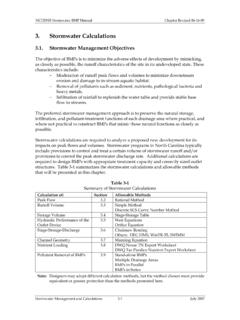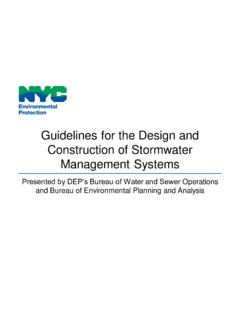Transcription of Crown & Cross-Slope - Pennsylvania State University
1 Crown & ,contact: CenterforDirt& GravelRoadsStudies,PennStateUniversity,2 15 TransportationResearchBuilding,Universit yPark,PA16802(Toll-FreePhone:1-866-668-6 683, Fax: 814-863-6787, Email: : AND Cross-Slope This bulletin illustrates basic methods to drain water from the road surface using three (3) different surface templates. Crown describes the side to side, or the cross-sectional shape of a road surface. Typically road segments are either center-crowned, in-sloped, or out-sloped. The degree of the side slope is typically measured in percent or degrees, or expressed as inches of fall per foot of road 1. Centerline CrownFigure 2. Out-slopingDirection of water flowDirection ofwater flowLC 12 LC 12 LC 12 Types of Crown Centerline CrownIn-slopingOut-slopingFigures not drawn to OF ROAD SURFACE Crown : A surface shape that sheds water to both sides of the road from a highpoint at the road center (Figure 1).)
2 In-slope: A surface configuration that drains water from the entire width of the road toward the cut-bank or up-slope side. Commonly used on steep side-hills for safety. Super-elevation of curves (banked curves) is a form of in-sloping that both supports traffic and drains the road Out-slope: Out-sloped road surfaces drain water from the entire width of the road toward the fill-bank or down-slope side. Elimination of road ditches on both sides of the road is possible with this surface shape. This shape best mimics natural drainage patterns and allows minor overland sheet flow is to flow across the road (Figure 2). Out-sloping is useful on low volume roads where side-slopes are gentle and concerns about winter icing are PURPOSE OF DRAINING THE ROAD SURFACEWhen standing water is allowed to penetrate the road surface, through retention in puddles or potholes, the road surface and the road base become soft and weak.
3 Flowing water that is allowed to concentrate on the road, such as in wheel tracks, causes damage and material loss from erosion. The purpose of surface drainage is to cause the water to leave the road as thin and non-erosive sheet flow in a direction and pattern chosen to suit various terrain and traffic conditions. 3/2019 MAINTAINING ROAD CROWNC ompaction, abrasion, and displacement of aggregate caused by traffic, as well as disturbance from snowplowing, inappropriate grading technique, and forces from flowing water work to deform the road surface. Over time, fines, which bind the coarse aggregate together, are lost. The unbound coarse material is displaced by traffic and accumulates along the edge of the road. This traps water on the traveled surface, allowing the water additional time to saturate and soften the road.
4 Compaction in the wheel tracks and windrows formed by displaced surface stone changes the shape of the surface cross-section. Additionally, water trapped on steeper road segments accumulates volume and velocity, eroding the driving surface, further changing the road s cross-sectional shape This increasingly restricts the ability to shed water from the road surface (see Illustration 1). The process starts slowly, but if maintenance is not completed on a timely basis the damage to the road can be severe.*Note - Specific procedures for re-establishing Crown during maintenance operations are detailed in the Grading Sequence with a Carbide-Tipped BladeTechnical Bulletin. Illustration 1. A Center-crowned road that has become misshapen over time.
5 The desired A shaped road surface has become a W shape, due to compaction of the wheel tracks and displacement of aggregate into windrows at the road center and road edges. water ponds on the road surface and softens the road. Or, drainage is forced to travel on the road surface causing erosion, loss of road material, and an increased need for maintenance. *Note - Additional methods of controlling this concentrated flow on the road surface are shown in the other Technical Crown with proper Cross-Slope . Road drainage flows without obstruction off the road surface into ditches or surrounding confined to road surfaceWater confined to road surfaceWindrow of displaced materialWindrow of displaced materialCLWater flows off the road : PAVED ROADS VS.
6 UNPAVED ROADSU npaved roads require more aggressive Crown than do paved roads. Pavement resists infiltration of water and will shed water more quickly than an unpaved surface. The Cross-Slope of a paved road is typically 2%, or of fall per horizontal foot of road width. A common problem is to shape a dirt or gravel road like a paved road. An unpaved road requires 2X to 3X the side-slope to guard against erosion and displacement. On unpaved surfaces , the recommended Cross-Slope is between 4% and 6%, or to of fall per horizontal foot of road width. The steeper Cross-Slope creates less potential for water to concentrate and scour the road surface , or to penetrate and weaken the road base. This equals less loss of purchased road material therefore and a smoother road with longer intervals between maintenance grading operations.
7 Over time, traffic and mother nature will wash out and drive out the Crown , so grading is routine and on-going maintenance. Ever road is different, and some roads will require more frequent grading than others. Road shoulders should be set at the same side-slope as the travelway, or slightly steeper. Pay attention to the elevation of your road shoulders. A shoulder only slightly higher that the road surface can trap a whole lot of water on your road and it will only get worse from there! TheUniversityiscommittedtoequalaccesstop rograms,facilities,admissionandemploymen tforallpersons. It isthepolicyoftheUniversitytomaintainanen vironmentfreeofharassmentandfreeofdiscri minationagainstanypersonbecauseofage,rac e,color,ancestry,nationalorigin,religion ,creed,servicein theuniformedservices(asdefinedin stateandfederallaw),veteranstatus,sex,se xualorientation,maritalorfamilystatus,pr egnancy,pregnancy-relatedconditions,phys icalormentaldisability,gender,perceivedg ender,genderidentity,geneticinformationo rpoliticalideas.
8 Discriminatoryconductandharassment,aswel lassexualmisconductandrelationshipviolen ce,violatesthedignityofindividuals,imped estherealizationoftheUniversity'seducati onalmission, theAffirmativeActionOffice,ThePennsylvan iaStateUniversity,328 BouckeBuilding,UniversityPark,PA16802-59 01,Email.










